Global Warming Alarmism Debate
| Art Hobson wrote a column about global warming which appeared in the Northwest Arkansas Times on May 15, 2011. Hogeye Bill wrote a letter to the editor criticizing Hobson's alarmist view. Steve Boss and Darrel Henschell wrote rebuttals to Hogeye's letter, with Hogeye replying on May 18. These are presented in reverse chronological order below. Click the name to jump to that section. The debate continues here on page 2. |
5/18/2011
Hogeye Bill's reply to Steve's and Darrel's rebuttals.
Steve wrote:"CO2 in the atmosphere has soaked up just about all the heat it can" and "CO2 could double or triple in the atmosphere with little effect on global temperature" are wholly incorrect assertions with no basis in fundamental physics.As proof for my first claim that CO2 in the atmosphere has soaked up just about all the heat it can, I offer this graph:
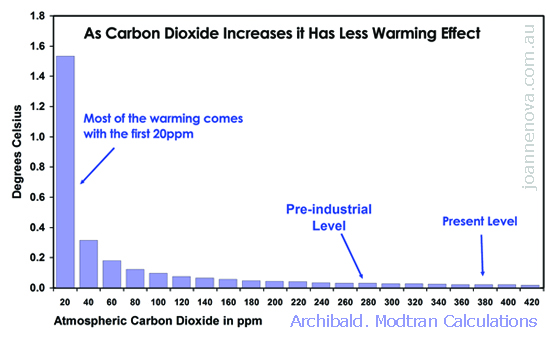
This comes from comes from David Archibald, and is based on climate sensitivity calculated by Craig Idso and published in peer reviewed literature (Idso 1998). A similar graph comes from Patrick Michaels, based on a climate sensitivity estimate from Richard Lindzen in his recent ERBE paper (Lindzen and Choi 2009). You can see both graphs and read a discussion of them on this web page.
As Joanne Nova, a former alarmist and author of The Skeptic's Handbook says:
I realize log curves are not something you want to reach out to the public with in detail, but I felt everyone who has done chemistry at university would grasp this point quickly. It explains the paradox: It's true that carbon has some warming effect, but it's also true that extra carbon doesn't have the same effect. When alarmists point out that the natural greenhouse effect causes "X degrees of warming," they usually fail to mention that the first 100pm does almost all of this, and no additional 100ppm will ever do as much. It's a lie by omission.If Darrel understands this logarithmic graph, he will realize that my comment "CO2 in the atmosphere has soaked up just about all the heat it can" is quite accurate, but his claim that "doubling of C02 will have profound implications for the planet's temperature" is naked alarmism.
Steve writes, "The fundamental physics of the outgoing long-wave radiation is not deniable." I agree. But as we see, more CO2 has a vanishingly small effect. Even IPCC agrees - it estimates only 1.1 degree of warming even if CO2 doubles. What is deniable is the IPCC models' grossly inflated feedback factors.
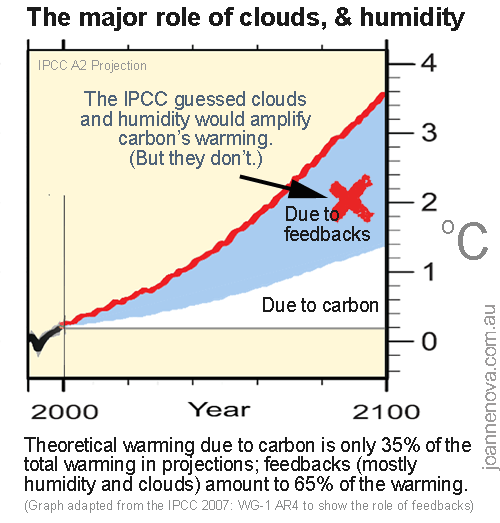
Steve claims that, "General Circulation Models (GCMs or 'climate models') are the most sophisticated computer programs climate scientists have and are not generally founded in assumptions." Joanne Nova totally disagrees, and gives citations:
Every prediction over 1.1 degrees relies on "feedback" of some sort. But what if that extra humidity turned into low clouds? What if it just rained out? What if fewer high clouds formed? Any of these would cool the planet.Also, the IPCC disagrees, saying "Uncertainty in projected climate change arises from three main sources; uncertainty in forcing scenarios, uncertainty in modelled responses to given forcing scenarios, and uncertainty due to missing or misrepresented physical processes in models."Without the effects of feedbacks to amplify carbon's minor warming, there is no disaster, and that's exactly what the observations tell us. Lindzen found that as the planet warms it gives off more radiation. Spencer found that as the planet warms, we get fewer high clouds. Paltridge found that humidity levels have fallen. The missing hot spot shows the models are wrong. There goes almost all of the warming. The models exaggerate by a factor of six. The 3.3°C scare is really only about half a degree of extra warmth.
Now, about the accuracy of the 20 plus IPCC models: both Steve and Darrel claim that the IPCC models are accurate for past climate history. But this evades my point, which was that the models have failed to predict. Anyone with a speadsheet knows that by changing your assumptions (in this case related mostly to feedback) you can "explain" the past. To settle this, we need only look up the 20+ IPCC predictions in the late 1990s, and see if they predicted the flattened trend since then. Here are some from the 2001 IPCC report (I'll even spot them a few years).
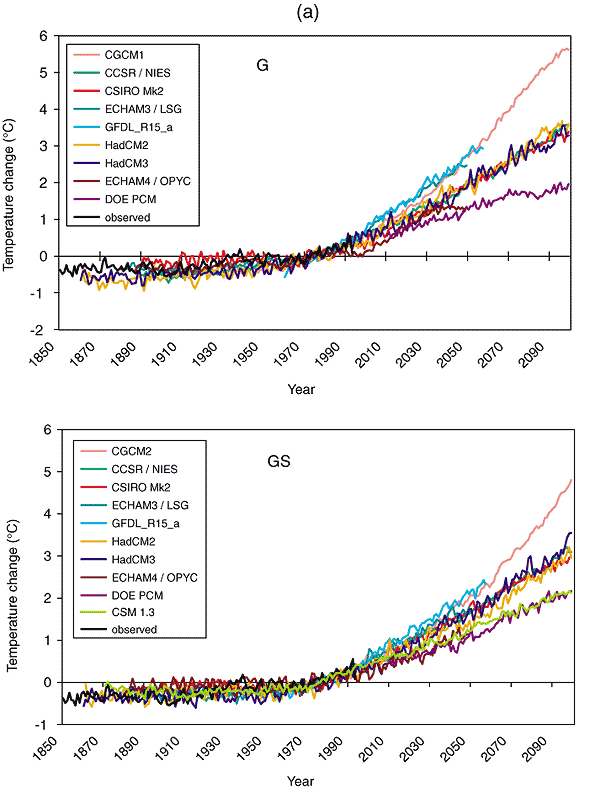
None of them predicted the nearly flat trend since 1998. All failed. Miserably. (To see more failed IPCC models, click on the link above.)
Darrel's own graph, Hansen's 2005 model, is a good example. It clearly demonstrates a gross overestimation of warming compared to what actually happened.
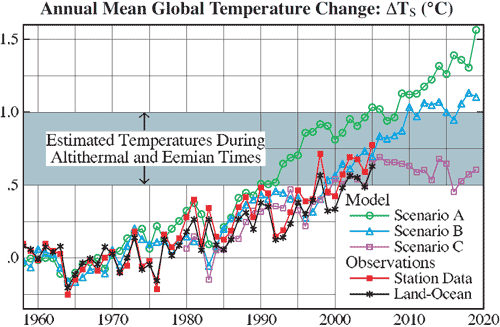
Hansen's scenerio "B" is his prediction, but actual temperature was more like scenerio "C" - a nearly flat trend.
I agree with Steve (contra Darrel) that climate models are not scientific evidence. ("Climate scientists do not, as a group, claim model outputs are scientific evidence of climate change or global warming.")
Some of Darrel's linked "evidence" is puzzling, e.g. to "prove" that climatologists understand the effect of CO2 on clouds, he links to an article that mentions clouds - twice! He doesn't deny the relatively flat trend since 1998; by crying "cherry picking" he apparently expects people to ignore the evidence. And he seems not to understand that all years near the peak of a continuous trend are necessarily near the peak.
It is noteworthy that the IPCC claim that cloud feedback triples the effect of CO2 is falsifiable. If their claim was true, there would be a "hot spot" in the atmosphere about 10 km up. But no such hot spot has been observed. Alarmists say that it is obscured (somehow) and invisible. Such faith! I don't believe in invisible pink unicorns.
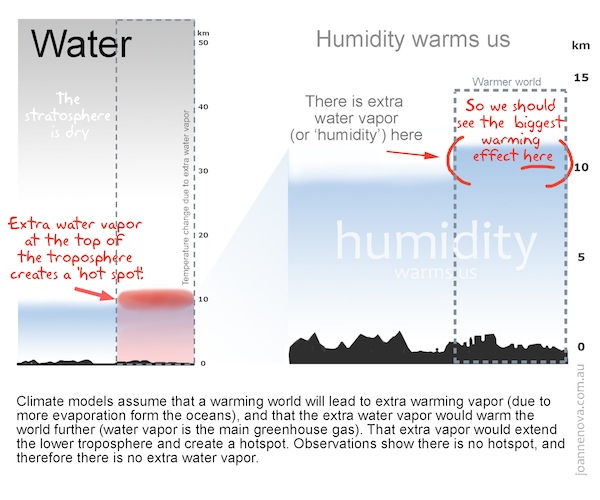
Most of this information, including the graphic above, can be seen in The Skeptic's Handbook, which besides being a trove of information about climate change, is a model of critical thinking. It's author wisely notes, "Who needs to transform economies to prevent half a degree of warming, most of which has already happened?" After all, the precautionary principle says we should refrain from actions which would retard economic development, risking hunger or starvation among third-world peoples. The burden of proof is on the alarmists. Climate change (which no one denies) should be handled by amelioration - harm reduction - not ultra-expensive authoritarian boondoggles.
Rebuttal By Steve Boss
This letter is replete with misconceptions and the rhetoric of anti-science. The author clearly has no training in climate science and his description of the atmospheric radiation balance shows a deep and fundamental lack of understanding of climate dynamics."CO2 in the atmosphere has soaked up just about all the heat it can" and "CO2 could double or triple in the atmosphere with little effect on global temperature" are wholly incorrect assertions with no basis in fundamental physics. At the present time, much of the outgoing long-wave radiation (what lay persons incorrectly term 'heat') still escapes to space because greenhouse gases in our atmosphere are not sufficiently abundant to absorb it all and thankfully so or our planet would be a searing Hell like Venus. However, greenhouse gases are demonstrably and irrefutably increasing in our atmosphere. Most of these additional greenhouse gases derive from activities of our technological society and addition of those greenhouse gases does, in fact, raise global atmospheric temperatures. The fundamental physics of the outgoing long-wave radiation is not deniable. Increasing the concentration of CO2 and other greenhouse gases results in additional absorption of outgoing long-w ave radiation and additional atmospheric heating - average global temperatures rise. This is a result required by simple physics and can be rigorously derived and defended mathematically. It is not a disputable opinion.
General Circulation Models (GCMs or 'climate models') are the most sophisticated computer programs climate scientists have and are not generally founded in assumptions. They are founded in the current state-of-knowledge regarding our mathematical understanding of atmospheric and oceanic physics. Our knowledge of the mathematics governing these complicated environmental systems is not complete, however, and this is the source of much of the uncertainty in climate models. In addition, the computational power to render these models at sufficiently high resolution is somewhat limited. This is another source of significant uncertainty. Climate scientists understand these limitations and are perfectly honest about them. Despite the well-known limitations of GCMs, their output does a rather good job of rendering current Earth climate when current data are input into the models. For this reason, climate scientists give credence to the output of models using scenarios with increased atmospheric CO2. Climate scientists do not, as a group, claim model outputs are scientific evidence of climate change or global warming.
Finally, we all agree with the author that society must begin transitioning away from reliance on fossil fuels to more sustainable energy sources for many reasons, and doing so will have many benefits to humanity and our environment.
Sun, May 15, 2011 at 8:27 PM, Darrel Henschell
Henschell's Rebuttal Of The Criticism
In the following I cite and respond to each of Bill's points directly. Perhaps you will find this of interest.
****** BILL [Art Hobson]... notes that there's more CO2 in the atmosphere since 1800. So what?">>
DAR Co2, while only representing a tiny .04% of our atmosphere, provides 60 degrees of warming. Without it, the average earth temperature would be below freezing. This makes it a profoundly powerful greenhouse gas. This was understood almost two centuries ago.
BILL "CO2 in the atmosphere has soaked up just about all the heat it can.">>
DAR That you have to use the weasel words "just about" suggest that even you are aware that the doubling of C02 will have profound implications for the planet's temperature. This was understood in 1896.
Let's review the history:
1) Greenhouse gasses absorb infrared radiation in the atmosphere and re-emit much of it back toward the surface, thus warming the planet (less heat escapes; Fourier, 1824).
1824 - French physicist Joseph Fourier describes the Earth's natural "greenhouse effect". He writes: "The temperature [of the Earth] can be augmented by the interposition of the atmosphere, because heat in the state of light finds less resistance in penetrating the air, than in re-passing into the air when converted into non-luminous heat."
2) CO2 is a greenhouse gas and thus has the capacity to warm the planet (Tyndall, 1858).
3) By burning fossil fuels, humans activities are increasing the greenhouse gas concentration of the Earth (Arrhenius, 1896).
4) Increased greenhouse gas concentrations lead to more heat being trapped, warming the planet further (Arrhenius, 1896).
For the rest of the timeline see:
http://www.aip.org/history/climate/co2.htm
BILL If you throw sponges in a bucket of water, after so many sponges the water is already absorbed.">>
DAR Except that, Co2 is now a "forcing" and also "feedback" whereas at the times in the distant past, the warming was started by long term cycles such as the Milankovitch cycle, and then causing a feedback effect of more CO2 release. This has been explained to you many times before. Note:
"The CO2 amplifies the warming and mixes through the atmosphere, spreading warming throughout the planet. So CO2 causes warming AND rising temperature causes CO2 rise."
http://www.skepticalscience.com/co2-lags-temperature-intermediate.htm
Bill "Throwing in more sponges makes virtually no difference.">>
DAR Again, the weasel word "virtually." That it does make a difference, even a small difference, is indeed the problem ("Climate sensitivity is around 3ºC for a doubling of CO2"). And the problem compounds yearly as we dump trillions of tons of Co2 and other gases into the air, which most likely will lead to further tipping point releases and acceleration from natural sources.
BILL CO2 could double or triple in the atmosphere with little effect on global temperature.">>
DAR It takes little effect, compounded over a few decades/centuries, along with methane and other tipping point gas releases, to initiate profound effects for the planet. And we are seeing the result already. The main concern is what is in the pipeline.
BILL "the 20 odd IPCC computer models predict catastrophic warming.">>
DAR Dr. Hobson never said "catastrophic," that's your word. But the best science certainly tells us catastrophic warming is possible, if not likely over a century or two. As the National Academy of Science found, agreement with the IPCC's findings practically unanimous:
"97-98% of the climate researchers most actively publishing in the field support the tenets of ACC outlined by the Intergovernmental Panel on Climate Change,..."
http://www.pnas.org/content/early/2010/06/04/1003187107.abstract
BILL "...computer model predictions are not scientific evidence as normally defined.">>
DAR This is climate science denier canard #6:
"While there are uncertainties with climate models, they successfully reproduce the past and have made predictions that have been subsequently confirmed by observations."
http://www.skepticalscience.com/climate-models-intermediate.htm
Successfully reproducing past and present conditions and making correct, testable predictions, is indeed science. And importantly, your point is false anyway because these things can be shown without relying upon computer models. See link directly below.
BILL "They are not observations, they are models based on many assumptions">>
DAR They mostly certainly do make predictions which have now been directly observed. All claims have assumptions.
BILL "model makers admit that they know next to nothing about the effect of CO2 on clouds,">>
DAR This is false. Learn about this here:
http://climateprogress.org/2009/12/02/realclimate-gavin-schmidit-what-fraction-of-global-warming-is-due-to-human-causes-vs-natural-causes/
BIll Do these IPCC models make accurate predictions? No.">>
DAR Absolutely they do. Again, see denier canard #6:
http://www.skepticalscience.com/climate-models-intermediate.htm
BILL: Not one of the 20 plus models predicted the flat trend in global temperature since 1998.">>
DAR This is absurd. Still playing the ludicrous game of cherry picking a single outlier year I see.
Scientists know, and state plainly, that twelve years is not considered statistically significant anyway.
Global warming is a general increase in temperature around an ever-increasing statistical mean, which is precisely what we are observing. Cherry picking a single year to find a false short term trend is ridiculous. No one has predicted, or ever would predict, each year to heat up in perfect stair step order.
Incidentally, 2005 was as hot as 1998, as was 2009, and 2010 was even hotter. Last year was the hottest year ever measured (and likely the hottest year in 2,000 years). Our current decade was hotter than the previous, and the one previous, and the one previous. That *is* statistically significant and exactly what was being predicted 35 years ago.
"20 warmest years having occurred since 1981 and with all 10 of the warmest years occurring in the past 12 years."
http://climate.nasa.gov/evidence/
BILL Appealing to models with a track record of failure is disingenuous.">>
DAR You forgot to show a track record of failure, and this is because the record is quite against you. In the 1970's, climatologists were overwhelmingly (6 to 1) predicting warming. And they have now been shown to be right.
BILL [Hobson] admits that the massive CO2 emission was the result, not the cause, of temperature warming.">>
DAR And that's why your objection is not irrelevant to the claim of currently observed, human caused, rapid warming. In this instance, humans are releasing the CO2 (also methane and nitrous oxide) and causing the forcing. Warming now follows. Again, the science of how this works was understood in the 1800's (including, incredibly, a very close approximation of what doubling would entail).
See again, denier canard #12:
http://www.skepticalscience.com/co2-lags-temperature-intermediate.htm
And note:
"The industrial activities that our modern civilization depends upon have raised atmospheric carbon dioxide levels from 280 parts per million to 379 parts per million in the last 150 years. The panel also concluded there's a better than 90 percent probability that human-produced greenhouse gases such as carbon dioxide, methane and nitrous oxide have caused much of the observed increase in Earth's temperatures over the past 50 years. ...the rate of increase in global warming due to these gases is very likely to be unprecedented within the past 10,000 years or more."
http://climate.nasa.gov/causes/
BILL "Crying "the sky is falling" is not a constructive way to seek solutions.">>
Bill didn't bother to give an example of anyone claiming the "sky is falling." The best science, and at least 97% of the experts with the proper training and expertise in this field say there is the potential for very great harm to the planet if we stay the course.
And unlike the climate science denial position, they have decades of peer reviewed science to support their claims.
One is left to wonder, are there are any other areas of science where Bill thinks he knows more than 97% of the experts in an extremely complex area of science? Or is it perhaps for political reasons and his devotion to the extreme positions of anarcho-capitalism and Ayn Rand objectivism that he finds it necessary to make this extraordinary and unscientific exception for the field of climate science?
Darrel
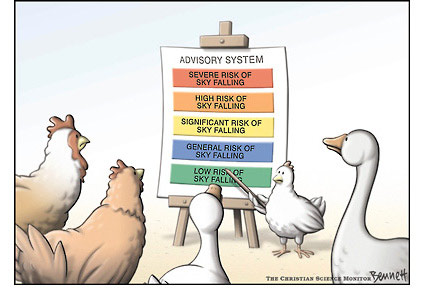
Hogeye Bill's Criticism
Letter to the editor of the NWA Times: Art Hobson is doing his Chicken Little routine again. Let's look at his three arguments that global warming will be catastrophic to mankind unless something drastic is done ("Possible Energy Futures, Part 3 5/15/2011).First he notes that there's more CO2 in the atmosphere since 1800. So what? CO2 in the atmosphere has soaked up just about all the heat it can. If you throw sponges in a bucket of water, after so many sponges the water is already absorbed. Throwing in more sponges makes virtually no difference. Similarly, as carbon dioxide increases it has less warming effect. Despite the climate alarmists' shrieks, CO2 could double or triple in the atmosphere with little effect on global temperature. Even the alarmist IPCC agrees; the claimed drastic increases in temperature are due to "feedback" based on unproved and dubious assumptions in their computer models.
Hobson's second point is that the 20 odd IPCC computer models predict catastrophic warming. First we should note that computer model predictionsare not scientific evidence as normally defined. They are not observations, they are models based on many assumptions - assumptions biased toward climate alarmism. For example, the model makers admit that they know next to nothing about the effect of CO2 on clouds, yet assume that feedback from clouds and humidity accounts for more than half of carbon's alleged'effect'. Do these IPCC models make accurate predictions? No. Not one of the 20 plus models predicted the flat trend in global temperature since 1998. Not a single one. Appealing to models with a track record of failure is disingenuous.
The third argument Hobson gives is really reaching - reaching back 55 million years to what he admits was a "geologically unique" event. Healso admits that the massive CO2 emission was the result, not the cause, of temperature warming.
I think the climate alarmists, with their ridiculous crisis- mongering, are doing a disservice to environmentalism. There are legitimate reasons to reduce pollution (which CO2 is not, contrary to political decrees.) There are strong reasons to reduce coal consumption and move to Sustainable energy. Crying "the sky is falling" is not a constructive way to seek solutions.
Possible energy futures, part 3
Part 1 outlined an energy future that would, by 2050, be based nearly entirely on efficiency and renewables such as solar. It's doable, and it's cheapest, but it's probably too smart for our anti-intellectual nation. So part 2 outlined a dumber plan that would still work: get dirtier energy from nuclear power plants and fossil fuel plants that utilize carbon dioxide (CO2) capture and storage. Here, I'll discuss what happens if we can't get our brains and our politics around some combination of energy futures 1 and 2.Under this "business as usual" case, global warming will probably be sufficient to usher in a new geological age by 2100. I'll present three arguments for this conclusion, any one of which should persuade a rational person that global warming is real, caused by humans, and likely to produce massive effects.
First, a common sense argument: Even most "climate skeptics" who think global warming is a hoax agree that fossil fuels have raised the atmospheric CO2 content by 40 percent since 1800. As you can see from the sharp spike in the graph that accompanies this article, this increase has been large, sudden, and unprecedented during the past 10,000 years. The longer geological record shows the present CO2 level to be unprecedented during 800,000 years. And everybody agrees that CO2 is one of the "greenhouse gases" that absorb infrared energy, warming the planet. So why, as Nobel-prize-winning physicist Burton Richter asks in his book "Beyond Smoke and Mirrors," wouldn't you expect the temperature to increase?
And sure enough, the planet's temperature has increased by 1.4 Fahrenheit degrees since 1860. Ice is melting in the Arctic ocean, in Greenland, and in mountain glaciers. Sea levels are rising, and accelerating. Just as one would expect from the additional atmospheric energy, there's been an increase in extreme weather such as we've recently experienced here: downpours, floods, tornadoes, hurricanes, heat strokes, droughts, and accompanying forest fires.
Second, an argument from the standard scientific process: Scientists are able to use well tested scientific theories together with powerful computers to predict future climate patterns and understand past patterns. When we apply these computer models to the past century, we find that the models agree with observed temperature trends and other data if human CO2 emissions are included in the input to the models, but do not agree with observations if these human emissions are not included in the models. The scientific conclusion is that, with high probability, human CO2 emissions are at least a partial cause of the observed temperature increase.
Third, and most ominously, an argument from geological history: Two excellent books--James Hansen's "Storms of my Grandchildren" and Bryan Lovell's "Challenged by Carbon"--have emphasized the relevance of the "Paleocene-Eocene Thermal Maximum" (PETM) to the recent warming. The PETM is a global temperature rise of 8 degrees occurring 55 million years ago that ended the Paleocene geological era and initiated the Eocene era. Studies of underwater rock layers show that the PETM was caused by 1000 billion tons of carbon released from the ocean floor into the atmosphere. This natural, but geologically unique, release was probably triggered by a slight natural warming of a portion of the ocean that in turn warmed the methane-containing ices that can form on the ocean floor. This would cause the ices to suddenly emit their methane (a greenhouse gas), which entered, and warmed, the atmosphere. This caused the release of CO2, just as a warmed carbonated drink emits CO2 bubbles, causing further warming, and so forth in a vicious circle.
Today we're well on the way to a repeat of the PETM event, caused this time by humans. Since 1900 AD, we have managed to inject 300 billion tons of carbon into the atmosphere. That's one-third of the way toward the level that caused the PETM. Under business as usual, we will have injected the amount that caused the PETM by 2100. But long before then, warming could melt the methane ices residing on the ocean floor, initiating the vicious circle that triggered the PETM.
The PETM raised ocean levels by 18 feet, acidified all the oceans, drastically changed animal life, and initiated a new and distinctively different geological age. CO2 levels remained significantly above normal for 170,000 years.
We're playing with fire, folks. To help us think about this problem, come to a discussion of books about global warming, at Fayetteville's Omni Center, 3274 Lee Avenue (off College Avenue, near Liquor World) this Friday, May 20, at 6:30 pm.